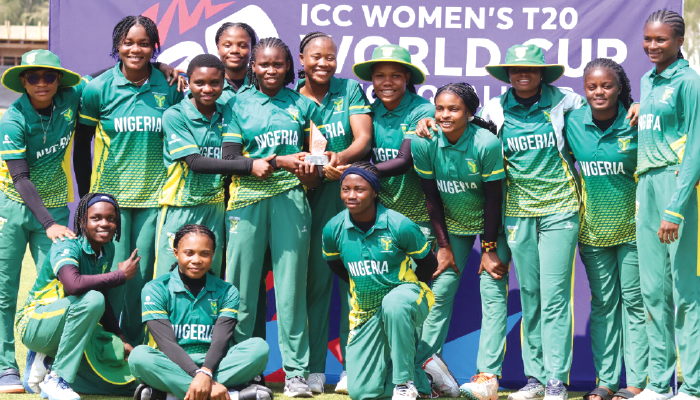Nigeria’s Female Yellow Greens, aiming to qualify for the 2026 Women’s T20 World Cup, experienced a setback in their campaign during the Africa Qualifier Division 1 tournament held in Namibia. Their hopes of securing a top-two finish and advancing to the global qualifiers were dashed following a narrow seven-run defeat against Kenya in a classification match. This loss relegated them to the seventh-place playoff against Sierra Leone, a significant blow to their World Cup aspirations. The team’s performance in Namibia fell short of expectations, forcing them to start their qualification journey from Division 2 in the next cycle.
The crucial match against Kenya saw Nigeria struggle to chase down a target of 106 runs. Despite Piety Lucky’s all-round contribution, picking up two wickets and top-scoring with 35 runs, the team’s batting faltered. A late surge by the Kenyan bowlers, particularly Melvin Khagoitsa, who claimed four wickets, proved decisive as Nigeria was bowled out for 98 runs, falling agonizingly short of victory. This loss compounded their earlier disappointment of failing to progress from the group stage, where they finished third. The team’s journey in the tournament began with high hopes, but their ambitions were ultimately thwarted by stronger opponents.
Nigeria’s participation in the Africa Qualifier Division 1 tournament represented a crucial opportunity to make a mark on the international stage. The team arrived in Namibia with the ambition of securing one of the two qualifying spots for the global qualifiers, a stepping stone towards the ultimate goal of competing in the T20 World Cup. However, their performance in the tournament reflected the challenges faced by emerging cricketing nations. Despite their efforts, they were unable to overcome tougher competition, highlighting the need for continued growth and development within the Nigerian women’s cricket program.
The defeat against Kenya underscored specific areas requiring improvement for the Nigerian team. Their batting performance, particularly in the chase, exposed vulnerabilities against disciplined bowling. The inability to maintain momentum and consistently score runs put them under pressure throughout the tournament. While individual contributions from players like Piety Lucky provided glimpses of potential, the team struggled to build substantial partnerships and sustain a consistent scoring rate. This ultimately hampered their ability to compete effectively against stronger teams like Kenya.
Looking ahead, Nigeria faces the challenge of regrouping and preparing for the next round of World Cup qualifiers, where they will have to compete from Division 2. This setback necessitates a thorough assessment of their performance in Namibia and a renewed focus on strengthening key areas. Addressing the batting frailties, developing consistent run-scoring strategies, and improving their ability to handle pressure situations will be crucial for future success. The team will also need to work on building greater team cohesion and developing a winning mentality to overcome challenges and achieve their World Cup qualification goals.
The experience in Namibia, though disappointing, provides valuable lessons for the Nigerian women’s cricket team. It highlights the competitive landscape of international cricket and the need for continuous improvement to compete at the highest level. The team’s journey towards World Cup qualification remains a long-term endeavor, requiring sustained effort, investment, and strategic planning. By learning from setbacks and focusing on development, the Female Yellow Greens can strive to build a stronger, more competitive squad capable of achieving their future aspirations.


